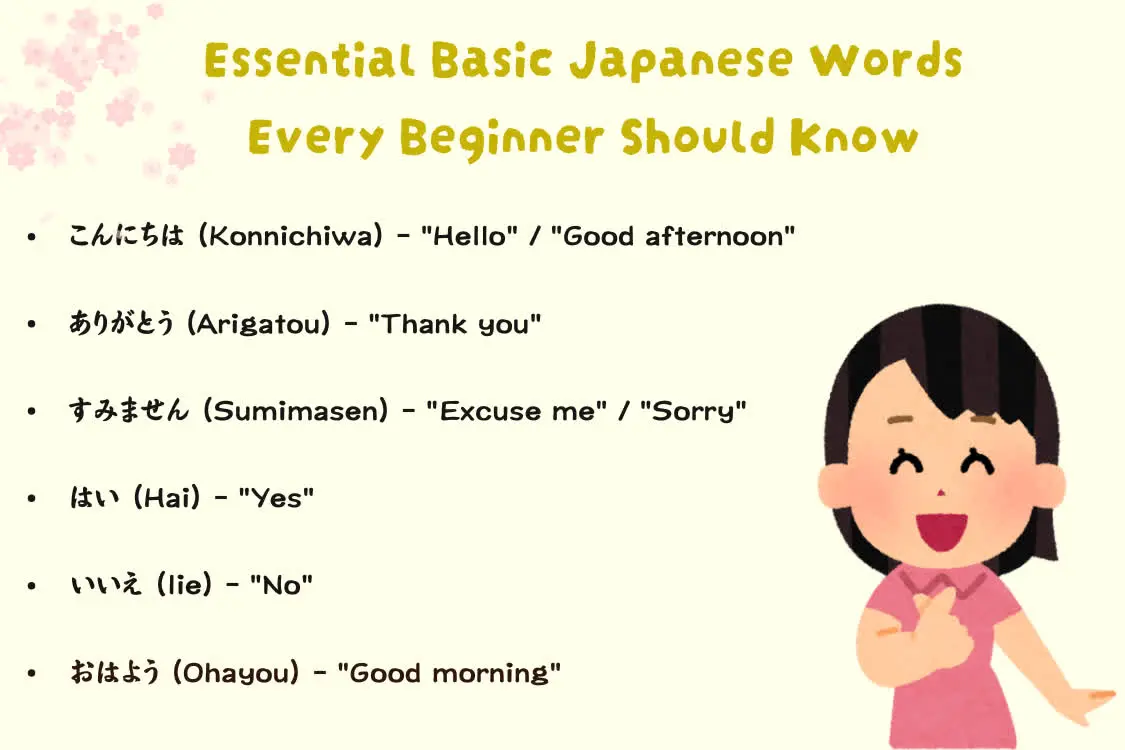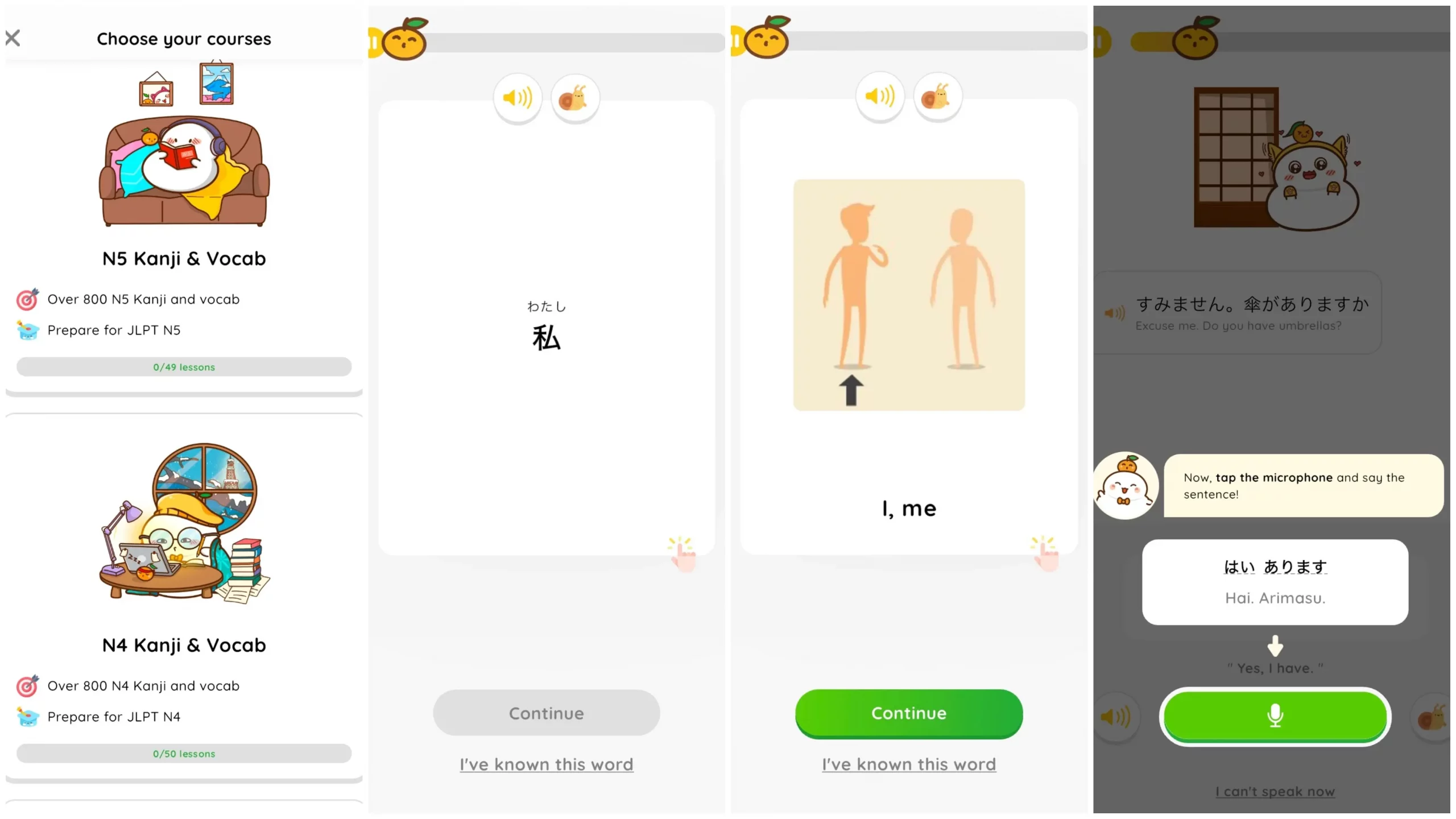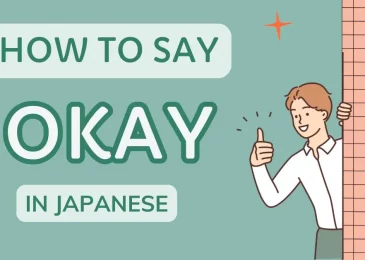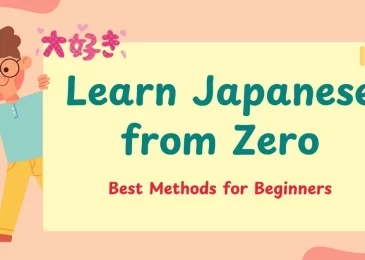Learning Japanese can be both an exciting and overwhelming experience, especially for beginners. The language features unique writing systems (Hiragana, Katakana, and Kanji), and its sentence structure might seem quite different from what you’re used to. However, one of the best ways to start your journey is by mastering the basic words in Japanese. These words are the building blocks of the language and will help you communicate in a variety of everyday situations, whether you’re traveling, shopping, or meeting new people.
In this guide, we’ll introduce you to 20 essential Japanese words that every beginner should know. These words will allow you to get by in basic conversations, and over time, they will provide a solid foundation for expanding your vocabulary. Let’s get started!
- こんにちは (Konnichiwa) – “Hello” / “Good afternoon”
- ありがとう (Arigatou) – “Thank you”
- すみません (Sumimasen) – “Excuse me” / “Sorry”
- はい (Hai) – “Yes”
- いいえ (Iie) – “No”
- おはよう (Ohayou) – “Good morning”
- どうぞ (Douzo) – “Please” / “Go ahead”
- お疲れ様 (Otsukaresama) – “Good work” / “Thank you for your hard work”
- 大丈夫 (Daijoubu) – “Okay” / “Alright”
- ごめんなさい (Gomen nasai) – “Sorry”
- いくら (Ikura) – “How much?”
- どこ (Doko) – “Where?”
- 何 (なに, Nani) – “What?”
- いい (ii) – “Good”
- おいしい (Oishii) – “Delicious”
- とても (Totemo) – “Very”
- 少し (Sukoshi) – “A little”
- 大きい (Ookii) – “Big” / “Large”
- 小さい (Chiisai) – “Small” / “Little”
- 楽しい (Tanoshii) – “Fun” / “Enjoyable”
- How to Use These Words Effectively
- How MochiKanji Can Boost Your Japanese Learning
- Conclusion
1. こんにちは (Konnichiwa) – “Hello” / “Good afternoon”
This is one of the first words most beginners learn in Japanese. こんにちは means “hello” or “good afternoon” and is typically used during the daytime. It’s a great way to greet someone casually.
- Example: こんにちは!お元気ですか? (Konnichiwa! Ogenki desu ka?) – “Hello! How are you?”
2. ありがとう (Arigatou) – “Thank you”
Expressing gratitude is an important part of Japanese culture, and ありがとう is the standard way of saying “thank you.” For more politeness, you can add ございます to say ありがとうございます.
- Example: ありがとうございます! (Arigatou gozaimasu!) – “Thank you very much!”
3. すみません (Sumimasen) – “Excuse me” / “Sorry”
Whether you’re trying to get someone’s attention or apologizing, すみません is an essential phrase. It’s used to say “excuse me,” “sorry,” or to thank someone for their help.
- Example: すみません、道を教えてください。 (Sumimasen, michi wo oshiete kudasai.) – “Excuse me, can you tell me the way?”
4. はい (Hai) – “Yes”
はい means “yes” and is essential in both formal and informal conversations. It’s used to affirm something, agree with someone, or acknowledge what was said.
- Example: はい、わかりました。 (Hai, wakarimashita.) – “Yes, I understand.”
5. いいえ (Iie) – “No”
The opposite of はい, いいえ is used to say “no.” It’s a polite way to decline or disagree. Remember, Japanese tends to be indirect, so いいえ is often used gently.
- Example: いいえ、大丈夫です。 (Iie, daijoubu desu.) – “No, it’s okay.”
6. おはよう (Ohayou) – “Good morning”
おはよう is the casual version of “good morning.” For more formality, you can say おはようございます (Ohayou gozaimasu). It’s a typical greeting to use when you first see someone in the morning.
- Example: おはよう!今日も頑張ろう! (Ohayou! Kyou mo ganbarou!) – “Good morning! Let’s do our best today!”
7. どうぞ (Douzo) – “Please” / “Go ahead”
Use どうぞ when offering something or inviting someone to do something. It’s a polite way of saying “please” or “go ahead.”
- Example: どうぞ、お先にどうぞ。 (Douzo, osaki ni douzo.) – “Please, go ahead.”
8. お疲れ様 (Otsukaresama) – “Good work” / “Thank you for your hard work”
お疲れ様 is often used in work or group settings to acknowledge someone’s effort or to say “good job.” It literally translates to “You must be tired,” but it’s a polite way of expressing appreciation.
- Example: お疲れ様でした! (Otsukaresama deshita!) – “Good work today!”
9. 大丈夫 (Daijoubu) – “Okay” / “Alright”
This word is used to confirm that something is fine or to reassure someone. It’s also used to say “I’m okay” after an accident or when someone is concerned.
- Example: 大丈夫ですか? (Daijoubu desu ka?) – “Are you okay?”
10. ごめんなさい (Gomen nasai) – “Sorry”
When you need to apologize, ごめんなさい is the standard way of saying “sorry.” It’s polite and widely used. You can shorten it to ごめん for a more casual tone.
- Example: ごめんなさい、遅れました。 (Gomen nasai, okuremashita.) – “Sorry, I’m late.”
11. いくら (Ikura) – “How much?”
When shopping or dining in Japan, いくら is the phrase you’ll use to ask about prices. It’s one of the first phrases you’ll need to know in practical situations.
- Example: このカメラはいくらですか? (Kono kamera wa ikura desu ka?) – “How much is this camera?”
12. どこ (Doko) – “Where?”
どこ is the word for “where.” It’s essential when you’re asking for directions or inquiring about locations.
- Example: 駅はどこですか? (Eki wa doko desu ka?) – “Where is the station?”
13. 何 (なに, Nani) – “What?”
何 (Nani) is the word for “what,” and it’s used in many everyday questions. It’s useful when you want to inquire about something.
- Example: それは何ですか? (Sore wa nani desu ka?) – “What is that?”
14. いい (ii) – “Good”
いい is a simple adjective used to describe something as “good” or “fine.” It’s versatile and commonly used to express approval.
- Example: この映画はいいですね。 (Kono eiga wa ii desu ne.) – “This movie is good, isn’t it?”
15. おいしい (Oishii) – “Delicious”
When enjoying food in Japan, おいしい is the word to describe something as delicious or tasty.
- Example: この寿司はおいしいです。 (Kono sushi wa oishii desu.) – “This sushi is delicious.”
16. とても (Totemo) – “Very”
とても is an adverb that means “very.” It’s used to emphasize the intensity of an adjective or verb.
- Example: とても楽しいです! (Totemo tanoshii desu!) – “It’s very fun!”
17. 少し (Sukoshi) – “A little”
The opposite of とても, 少し (sukoshi) means “a little” or “a bit.” It’s useful when you want to indicate a small amount or degree.
- Example: 少し待ってください。 (Sukoshi matte kudasai.) – “Please wait a little.”
18. 大きい (Ookii) – “Big” / “Large”
大きい is used to describe something that is large or big, whether it’s a physical object or an abstract concept.
- Example: この家は大きいです。 (Kono ie wa ookii desu.) – “This house is big.”
19. 小さい (Chiisai) – “Small” / “Little”
On the flip side, 小さい means “small” or “little.” It’s useful when describing the size of objects or things.
- Example: 小さい子どもがいます。 (Chiisai kodomo ga imasu.) – “There is a small child.”
20. 楽しい (Tanoshii) – “Fun” / “Enjoyable”
When you want to describe an activity or experience as enjoyable, use 楽しい. It’s a common word used to express fun or happiness.
- Example: このパーティーは楽しいです。 (Kono paatii wa tanoshii desu.) – “This party is fun.”
How to Use These Words Effectively
Knowing basic Japanese words is just the beginning. To truly become fluent, you need to practice using them in real-world conversations. Here are a few tips:
- Practice Regularly: The best way to solidify your vocabulary is through practice. Find a language exchange partner or tutor to help you use these words in conversation.
- Use Flashcards: Apps like MochiKanji are great for memorizing vocabulary. The spaced repetition system helps reinforce words and ensures you don’t forget them.
- Immerse Yourself: Watch Japanese TV shows, listen to podcasts, and read Japanese books to hear how these words are used in context.
How MochiKanji Can Boost Your Japanese Learning
MochiKanji is an excellent tool for learning Japanese vocabulary and Kanji, suitable for learners from N5 to N2 levels. Here’s how it can help you:
- Spaced Repetition (SRS): The app uses SRS to help you memorize words and Kanji efficiently, reinforcing them at optimal intervals for long-term retention.
- Personalized Learning Paths: Customize your study plan based on your goals, whether you’re focused on basic vocabulary, JLPT preparation, or advanced Kanji mastery.
- Interactive Quizzes & Flashcards: Test your knowledge with quizzes and flashcards, complete with native audio to help with pronunciation and listening skills.
- Real-Life Practice: Learn vocabulary in context with example sentences and practice scenarios, improving your ability to communicate naturally in everyday situations.
With these features, MochiKanji makes learning Japanese more engaging and effective, helping you master both vocabulary and Kanji while improving your communication skills.
Conclusion
Mastering basic Japanese words is an essential first step in your language-learning journey. These 20 words are not only the foundation of everyday conversations but also serve as building blocks for expanding your vocabulary as you progress. By practicing regularly, immersing yourself in the language, and using helpful tools like MochiKanji, you’ll be well on your way to improving your Japanese skills.
Remember, language learning takes time and effort, but with consistent practice and the right resources, you’ll find yourself becoming more confident in speaking, reading, and understanding Japanese. Keep exploring, stay motivated, and enjoy the process – every word you learn brings you one step closer to mastering the language!








